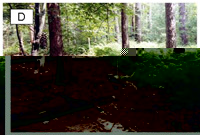THE ECOLOGICAL QUESTIONHow have pine and hardwood stands in a temperate forest responded to 15 years of nitrogen additions? ECOLOGICAL CONTENTforest ecosystem, nitrogen (N) deposition, primary productivity, soil respiration, microbial community, replication WHAT STUDENTS DOStudents work with data to ask and address questions about effects of chronic N additions to two forest types. Four Microsoft Excel files on net primary productivity, tree photosynthetic capacity, soil respiration, and soil microbial biomass allow students to consider effects of long-term N enrichment in northeast US forests. Students in a basic ecology class can use part of the data set; more advanced students, in a plant ecology class for example, can work up all the data. SKILLSAsking and addressing questions with data, critical thinking, graph preparation, data analysis and interpretation, and writing or oral presentation. STUDENT-ACTIVE APPROACHESStudents examine data, ask their own questions, and then propose the most meaningful figures to get at these questions. A set of open-ended prompts are provided. ASSESSABLE OUTCOMESSimple statistics (means and standard errors), graphs from spreadsheet data, and written and oral communication of results and conclusions. SOURCEBauer, G.A., F.A. Bazzaz, R. Minocha, S. Long, A. Magill, J. Aber, and G.M. Berntson. 2004. Effects of chronic nitrogen additions on tissue chemistry, photosynthetic capacity, and carbon sequestration potential of a red pine (Pinus resinosa Ait.) stand in the NE United States. Forest Ecology and Management 196:173-186. Bowden, R.D., E. Davidson, K. Savage, C.Arabia, and P. Steudler. 2004. Chronic nitrogen additions reduce total soil respiration and microbial respiration in temperate forest soils at the Harvard Forest. 2004. Forest Ecology and Management 196:43-56. Frey, S.D., M. Knorr, J. Parrent, and R.T. Simpson. 2004. Chronic nitrogen enrichment affects the structure and function of the soil microbial community in a forest ecosystem. Forest Ecology and Management 196:159-171. Magill, A.H., J.D. Aber, W.S. Currie, K.J. Nadelhoffer, M.E. Martin, W.H. McDowell, J.M. Melillo, and P. Steudler. 2004. Ecosystem response to 15 years of chronic nitrogen additions at the Harvard Forest LTER, Massachusetts, USA. Forest Ecology and Management 196:7-28. AUTHORSSerita D. Frey Department of Natural Resources, University of New Hampshire, Durham, NH, 03824, serita.frey@unh.edu ACKNOWLEDGMENTSThis exercise is based on data published in a special issue of Forest Ecology and Management that provides a detailed report on results from the first 15 years of chronic N additions to pine and hardwood stands at the Harvard Forest in Petersham, MA, USA. I greatly acknowledge John Aber, Alison Magill, Richard Bowden, and Guntrum Bauer whose data and ideas contributed to this activity. Funding to develop this exercise was provided by the National Science Foundation (DEB-0224917). CITATIONFrey, Serita D. April 2006, posting date. |

Harvard Forest
The control (A and C) and high N addition (B and D) plots in the hardwood (A and B) and pine (C and D) stands at the Chronic Nitrogen Addition Study at the Harvard Forest in central Massachusetts (USA). (Photos courtesy Eric Saas, University of New Hampshire. Used with permission.)
|